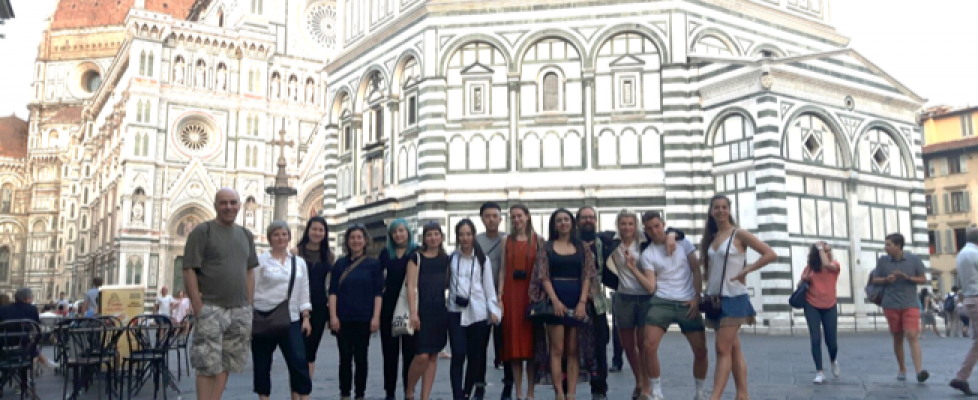MA Art and Science study trip to Florence, Italy
Words and images by Priya Odedra and Caglar Tahiroglu
With the culmination of the academic year, students from the MA Art and Science course at Central Saint Martins visited Florence between 5-9 June 2017 to explore the birthplace of Art and Science. The trip was a fascinating addition to the interdisciplinary course comprised of students from diverse backgrounds. It seems that by the end of the week everyone had found an area of interest: from historical artefacts belonging to the Medici to renowned Renaissance artworks, striking wax-work models to delectable Italian cuisine! In conjunction with the educational and cultural aspects, which supplemented our academic objectives, the beautiful weather coupled with one of the most undeniably beautiful cities allowed us to unwind after a hectic year. It also allowed the graduating students to celebrate their completion of the Masters so all-in-all, it was an all-round, all-inclusive trip!
After dining at a local food market, Mercato centrale di Firenze, with a plethora of choice and wandering around the city on our first night, we were feeling enthused and well rested for our first day in Florence. This involved visiting the Accademia di belle Arti di Firenze (Florence Academy of Fine Arts). Our tutor, Roberta Ballestriero introduced us to her colleagues who work at the Accademia. Prof. Anna Luppi took us to the library, which was full of Renaissance relics. In particular, we were fortunate enough to see the original manuscript of Andreas Vesalius’ de Humani Corporis Fabrica (1543). As Vesalius is often considered the forefather of human anatomy, seeing his work was fascinating. We also witnessed the anatomical illustrations of the German artist, Albrecht Dürer, during a visit to Florence in 1500’s. It was interesting to observe how both the scientist (Vesalius) and artist (Dürer) approached the topic of the human body in different ways; Vesalius’ figures were expressive and intricate, whilst Durer predominantly explored physiological proportion and measurements.
After this, we had the opportunity to meet students currently studying at the Accademia, as well as visit the studio of Prof. Raffaella Nappo. Some of the MAAS students gave presentations explaining their work also, in a sort of artistic and cultural exchange. It was interesting and engaging to learn about each other’s practices and projects. We had lunch with the students at their canteen and exchanged contact details for potential future collaborations.


In the afternoon, we were lucky enough to partake in a life drawing class at the Accademia. Some of us were quite rusty, nevertheless, this was a great experience.

The next day, Roberta took us to the The Museum of Zoology and Natural History, La Specola, University of Florence, where we continued the anatomical observations. However, this time, the artefacts were 3-dimensional and made in the 18th Century rather than from the 16th Century. The items in question were anatomical wax models with idiosyncratic expressions. They were in equal measures tantalisingly beautiful examples of human artistry and utterly grotesque corporeal representations. We found out that the museum was first opened in 1775 to the public rather than solely the elite, highlighting that it was rather progressive for its time. We were also curious as to why the wax has not melted or the colours faded since then. Roberta, one of the few experts on the history of ceroplastics and wax figures, explained that if kept in the right conditions (cool, dry environment) wax is a durable material to use. She was the president of the “International Congress on Wax Modelling” in London last year, the first congress on this topic since the 1970s (the first one was held in 1975 in Florence at the Museum of La Specola).
Prof. Fausto Barbagli, one of the curators of the Natural History Museum, also gave us a guided tour of the “Observatory” (Ex Osservatorio astronomico 1780-1789, restored and opened to the public after 150 years thanks to Prof. Barbagli), which offered a delightful view of Florence. We were shown an instrument that used the sunlight and a pinhole to measure the earth’s movement. For astrology lovers, there were also references to the zodiac signs all around the room.


Another highlight was a visit to Bill Viola’s exhibition, “Electronic Renaissance” at the Palazzo Strozzi. This involved remarkable interactions between Renaissance masterpieces and contemporary video art, amalgamating and appreciating fine art mediums on a universal and timeless scale.
During our spare time, we did some sight-seeing, making the most of exploring Florence and learning about the extensive historical and cultural attributes of the city. Some of us visited Michelangelo’s acclaimed David, the Duomo, the Medici Palace and Boboli gardens, Dante’s house and the Uffizi gallery, housing masterpieces like Botticelli’s Birth of Venus and Da Vinci’s Annunciation. Others preferred to delve into the contemporary art scene of Florence. Whichever route we took, we could always agree on meeting for pizza, pasta, gelato and Aperol Spritz in the evenings!
Overall, the trip to Florence was inspiring and insightful, enlightening us about the origins of Art and Science as disciplines, along with how they have evolved since the Renaissance days. Undoubtedly, this experience will lead to creative endeavours and collaborations in the future!
Comments from students:
Tere Chadwick:
‘’It was an incredible experience. It wouldn’t have been the same without Roberta Ballestriero”
Caglar Tahiroglu:
‘This trip was a good collaborative experience as we had the chance to visit the studios of the Fine Art Academy in Florence, as well as meet with tutors and student. We also had the opportunity to present our work. It seems that we made some long-lasting liaisons as students invited us to their exhibition afterwards and I certainly intend to keep in contact with them!”
